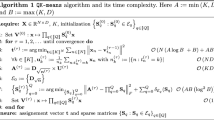Abstract
It has already been proven that under certain circumstances dictionary learning for sparse representations is equivalent to conventional k-means clustering. Through additional modifications on sparse representations, it is possible to generalize the notion of centroids to higher orders. In a related algorithm which is called k-flats, q-dimensional flats have been considered as alternative central prototypes. In the proposed formulation of this paper, central prototypes are instead simplexes or even more general polytopes. Using higher-dimensional, nonconvex prototypes may alleviate the curse of dimensionality while also enabling to model nonlinearly distributed datasets successfully. The proposed framework in this study can further be applied in supervised settings flexibly through one-class learning and also in other nonlinear frameworks through kernels.



Similar content being viewed by others
References
Deza, M.M., Deza, E.: Encyclopedia of Distances. Springer, Berlin (2016)
Sibson, R.: SLINK: an optimally efficient algorithm for the single-link cluster method. Comp. J. 16(1), 30–34 (1973)
Lloyd, S.: Least squares quantization in PCM. IEEE Trans. Inf. Theory 28(2), 129–137 (1982)
Carson, C., Belongie, S., Greenspan, H., Malik, J.: Blobworld: image segmentation using expectation-maximization and its application to image querying. IEEE Trans. Pattern Anal. Mach. Intell. 24(8), 1026–1038 (2002)
Novak, P., Neumann, P., Macas, J.: Graph-based clustering and characterization of repetitive sequences in next-generation sequencing data. BMC Bioinform. 11(1), 378 (2010)
Aloise, D., Deshpande, A., Hansen, P., Popat, P.: NP-hardness of Euclidean sum-of-squares clustering. Mach. Learn. 75(2), 245–248 (2009)
Scholkopf, B., Smola, A., Muller, K.R.: Nonlinear component analysis as a kernel eigenvalue problem. Neural Comput. 10(5), 1299–1319 (1998)
Dhillon, I.S., Guan, Y., Kulis, B.: Kernel k-means: spectral clustering and normalized cuts. In: ACM International Conference on Knowledge Discovery and Data Mining, pp. 551–556 (2004)
Fred, A.L.N., Jain, A.K.: Data clustering using evidence accumulation. In: Object Recognition Supported User Interaction for Service Robots, pp. 276–280 (2002)
Hore, P., Hall, L.O., Goldgof, D.B.: A scalable framework for cluster ensembles. Pattern Recognit. 42(5), 676–688 (2009)
Iam-on, N., Garrett, S.: Linkclue: a matlab package for link-based cluster ensembles. J. Stat. Softw. 36(9), 1–36 (2010)
Cheung, Y.M.: k*-means: a new generalized k-means clustering algorithm. Pattern Recognit. Lett. 24(15), 2883–2893 (2003)
Pelleg, D., Moore, A.W.: X-means: extending k-means with efficient estimation of the number of clusters. In: International Conference on Machine Learning, pp. 727–734 (2000)
Cheng, Y.: Mean shift, mode seeking, and clustering. IEEE Trans. Pattern Anal. Mach. Intell. 17(8), 790–799 (1995)
Bradley, P.S., Mangasarian, O.L.: K-plane clustering. J. Glob. Optim. 16(1), 23–32 (2000)
Tseng, P.: Nearest q-flat to m points. J. Optim. Theory Appl. 105(1), 249–252 (2000)
Canas, G., Poggio, T., Rosasco, L.: Learning manifolds with k-means and k-flats. In: Pereira, F., Burges, C.J.C., Bottou, L., Weinberger, K.Q. (eds.) Advances in Neural Information Processing Systems. Curran Associates, Inc., pp. 2465–2473 (2012)
Szlam, A., Sapiro, G.: Discriminative k-metrics. In: International Conference on Machine Learning, pp. 1009–1016 (2009)
Pati, Y.C., Rezaiifar, R., Krishnaprasad, P.S.: Orthogonal matching pursuit: recursive function approximation with applications to wavelet decomposition. In: Asilomar Conference on Signals, Systems, and Computers, pp. 40–44 (1993)
Wang, H., Celik, T.: Sparse representation-based hyperspectral image classification. Signal Image Video Process. 12(5), 1009–1017 (2018)
Abolghasemi, V., Ferdowsi, S., Sanei, S.: Fast and incoherent dictionary learning algorithms with application to FMRI. Signal Image Video Process. 9(1), 147–158 (2015)
Meier, L., Van De Geer, S., Buhlmann, P.: The group lasso for logistic regression. J. R. Stat. Soc. Ser. B 70(1), 53–71 (2008)
Eldar, Y.C., Mishali, M.: Robust recovery of signals from a structured union of subspaces. IEEE Trans. Inf. Theory 55(11), 5302–5316 (2009)
Elhamifar, E., Vidal, R.: Sparse subspace clustering. In: IEEE Computer Vision and Pattern Recognition, pp. 2790–2797 (2009)
Aharon, M., Elad, M., Bruckstein, A.: K-SVD: an algorithm for designing overcomplete dictionaries for sparse representation. IEEE Trans. Signal Process. 54(11), 4311–4322 (2006)
Yu, K., Zhang, T., Gong, Y.: Nonlinear learning using local coordinate coding. In: Bengio, Y., Schuurmans, D., Lafferty, J.D., Williams, C.K.I., Culotta, A. (eds.) Advances in Neural Information Processing Systems. Curran Associates, Inc., pp. 2223–2231 (2009)
Wang, J., Yang, J., Yu, K., Lv, F., Huang, T., Gong, Y.: Locality-constrained linear coding for image classification. In: IEEE Computer Vision and Pattern Recognition, pp. 3360–3367 (2010)
Zhang, Z., Xu, Y., Yang, J., Li, X., Zhang, D.: A survey of sparse representation: algorithms and applications. IEEE Access 3, 490–530 (2015)
Golubitsky, O., Mazalov, V., Watt, S.M.: An algorithm to compute the distance from a point to a simplex. ACM Commun. Comput. Algebra 46, 57–57 (2012)
Duchi, J., Shalev-Shwartz, S., Singer, Y., Chandra, T.: Efficient projections onto the l1-ball for learning in high dimensions. In: International Conference on Machine Learning, pp. 272–279 (2008)
Celebi, M.E., Kingravi, H.A., Vela, P.A.: A comparative study of efficient initialization methods for the k-means clustering algorithm. Expert Syst. Appl. 40(1), 200–210 (2013)
Lindemann, P.: The Gilbert–Johnson–Keerthi Distance Algorithm. Alg Media Informatics (2009)
Reynolds, D. (2015) Gaussian mixture models. In: Li, S.Z., Jain, A.K. (eds.) Encyclopedia of Biometrics. Springer, Boston, pp. 827–832. https://doi.org/10.1007/978-1-4899-7488-4_196
Bishop, C.M.: Pattern Recognition and Machine Learning. Springer, Berlin (2006)
Dheeru, D., Taniskidou, E.K.: UCI Machine Learning Repository (2017)
LeCun, Y., Cortes, C., Burges, C.J.C.: MNIST Handwritten Digit Database (2010)
van der Maaten, L., Hinton, G.: Visualizing data using t-SNE. J. Mach. Learn. Res. 9, 2579–2605 (2008)
Acknowledgements
Authors are grateful to Prof. Dr. Turker Ince for fruitful discussions, and for his constructive comments that greatly improved the manuscript.
Author information
Authors and Affiliations
Corresponding author
Additional information
Publisher's Note
Springer Nature remains neutral with regard to jurisdictional claims in published maps and institutional affiliations.
Electronic supplementary material
Below is the link to the electronic supplementary material.
Rights and permissions
About this article
Cite this article
Oktar, Y., Turkan, M. K-polytopes: a superproblem of k-means. SIViP 13, 1207–1214 (2019). https://doi.org/10.1007/s11760-019-01469-6
Received:
Accepted:
Published:
Issue Date:
DOI: https://doi.org/10.1007/s11760-019-01469-6




